
Elaine Marie Catherine de Kooning was an Abstract Expressionist and Figurative Expressionist painter in the post-World War II era. She wrote extensively on the art of the period and was an editorial associate for Art News magazine.
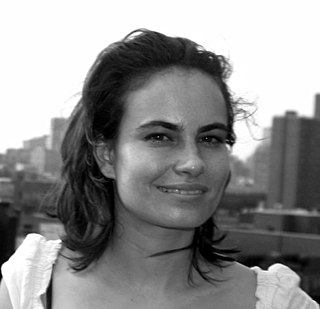
Inka Essenhigh is an American painter based in New York City. Throughout her career, Essenhigh has had solo exhibitions at galleries such as Deitch Projects, Mary Boone Gallery, 303 Gallery, Stefan Stux Gallery, and Jacob Lewis Gallery in New York, Kotaro Nukaga, Tomio Koyama Gallery in Tokyo, and Il Capricorno in Venice.

Amy Sillman is a New York-based visual artist, known for process-based paintings that move between abstraction and figuration, and engage nontraditional media including animation, zines and installation. Her work draws upon art historical tropes, particularly postwar American gestural painting, as both influences and foils; she engages feminist critiques of the discourses of mastery, genius and power in order to introduce qualities such as humor, awkwardness, self-deprecation, affect and doubt into her practice. Profiles in The New York Times, ARTnews, Frieze, and Interview, characterize Sillman as championing "the relevance of painting" and "a reinvigorated mode of abstraction reclaiming the potency of active brushwork and visible gestures." Critic Phyllis Tuchman described Sillman as "an inventive abstractionist" whose "messy, multivalent, lively" art "reframes long-held notions regarding the look and emotional character of abstraction."

Susan Charna Rothenberg was an American contemporary painter, printmaker, sculptor, and draughtswoman. She became known as an artist through her iconic images of the horse, which synthesized the opposing forces of abstraction and representation.

Laurie Simmons is an American artist best known for her photographic and film work. Art historians consider her a key figure of The Pictures Generation and a group of late-1970s women artists that emerged as a counterpoint to the male-dominated and formalist fields of painting and sculpture. The group introduced new approaches to photography, such as staged setups, narrative, and appropriations of pop culture and everyday objects that pushed the medium toward the center of contemporary art. Simmons's elaborately constructed images employ psychologically charged human proxies—dolls, ventriloquist dummies, mannequins, props, miniatures and interiors—and also depict people as dolls. Often noted for its humor and pathos, her art explores boundaries such as between artifice and truth or private and public, while raising questions about the construction of identity, tropes of prosperity, consumerism and domesticity, and practices of self-presentation and image-making. In a review of Simmons's 2019 retrospective at the Museum of Contemporary Art, Chicago, critic Steve Johnson wrote, "Collectively—and with a sly but barbed sense of humor—[her works] challenge you to think about what, if anything, is real: in our gender roles, and our cultural assumptions, and our perceptions of others."

Howardena Pindell is an American artist, curator, critic, and educator. She is known as a painter and mixed media artist who uses a wide variety of techniques and materials. She began her long arts career working with the New York Museum of Modern Art, while making work at night. She co-founded the A.I.R. gallery and worked with other groups to advocate for herself and other female artists, Black women in particular. Her work explores texture, color, structures, and the process of making art; it is often political, addressing the intersecting issues of racism, feminism, violence, slavery, and exploitation. She has created abstract paintings, collages, "video drawings," and "process art" and has exhibited around the world.
Carol Diehl is an American artist, art critic and poet. In addition to her writing, most recently appearing in her blog Art Vent, she is best known for her paintings, which have often documented daily life in a manner described as diaristic, even compulsive, using dense, painterly, often indecipherable words, numbers and symbols in grid or geometric frameworks. Diehl has also been a prolific art critic, having contributed features and reviews to numerous periodicals, including Art in America, ARTnews, and Art + Auction, as well as to books and artist catalogues. In the 1990s, she became active in New York's performance poetry scene. Diehl lives in New York City and southwestern Massachusetts. She has two sons, Matt Diehl and Adam Diehl.

Peter Plagens is an American artist, art critic, and novelist based in New York City. He is most widely known for his longstanding contributions to Artforum and Newsweek, and for what critics have called a remarkably consistent, five-decade-long body of abstract formalist painting. Plagens has written three books on art, Bruce Nauman: The True Artist (2014), Moonlight Blues: An Artist's Art Criticism (1986) and Sunshine Muse: Modern Art on the West Coast, 1945-70 (1974), and two novels, The Art Critic (2008) and Time for Robo (1999). He has been awarded major fellowships for both his painting and his writing. Plagens's work has been featured in surveys at the Museum of Modern Art, Los Angeles County Museum of Art (LACMA), Whitney Museum, and PS1, and in solo exhibitions at the Hirshhorn Museum and Las Vegas Art Museum. In 2004, the USC Fisher Gallery organized and held a 30-year traveling retrospective of his work. Critics have contrasted the purely visual dialogue his art creates—often generating more questions than answers—with the directness of his writing; they also contend that the visibility of his bylines as a critic has sometimes overshadowed his artmaking—unduly. Los Angeles Times critic David Pagel described Plagens's painting as a "fusion of high-flying refinement and everyday awkwardness" with an intellectual savvy, disdain for snobbery and ungainliness he likened to Willem de Kooning's work. Reviewing Plagens's 2018 exhibition, New York Times critic Roberta Smith called the show an "eye-teasing sandwich of contrasting formalist strategies," the hard-won result of a decade of focused experimentation.

Thornton Willis is an American abstract painter. He has contributed to the New York School of painting since the late 1960s. Viewed as a member of the Third Generation of American Abstract Expressionists, his work is associated with Abstract Expressionism, Lyrical Abstraction, Process Art, Postminimalism, Bio-morphic Cubism and Color Field painting.
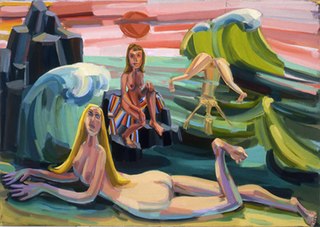
Judith Linhares is an American painter, known for her vibrant, expressive figurative and narrative paintings. She came of age and gained recognition in the Bay Area culture of the 1960s and 1970s and has been based in New York City since 1980. Curator Marcia Tucker featured her in the influential New Museum show, "'Bad' Painting" (1978), and in the 1984 Venice Biennale show, "Paradise Lost/Paradise Regained: American Visions of the New Decade." Linhares synthesizes influences including Expressionism, Bay Area Figuration, Mexican modern art and second-wave feminism, in work that flirts with abstraction and balances visionary personal imagery, expressive intensity, and pictorial rigor. Art historian Whitney Chadwick wrote, "Linhares is an artist for whom painting has always mattered as the surest path of synthesizing experience and interior life," her works "emerging as if by magic from an alchemical stew of vivid complementary hues and muted tonalities." Critic John Yau describes her paintings "funny, strange, and disconcerting," while writer Susan Morgan called them "unexpected and indelible" images exploring "an oddly sublime territory where exuberant bliss remains inseparable from ominous danger."
Torkwase Dyson is an interdisciplinary artist based in Beacon, New York, United States. Dyson describes the themes of her work as "architecture, infrastructure, environmental justice, and abstract drawing." Her work is informed by her own theory of Black Compositional Thought. This working term considers how spatial networks—paths, throughways, water, architecture, and geographies—are composed by Black bodies as a means of exploring potential networks for Black liberation. She is represented by Pace Gallery and Richard Gray Gallery.
Jan Cicero Gallery was a contemporary art gallery founded and directed by Jan Cicero, which operated from 1974 to 2003, with locations in Evanston and Chicago, Illinois and Telluride, Colorado. The gallery was noted for its early, exclusive focus on Chicago abstract artists at a time when they were largely neglected, its role in introducing Native American artists to mainstream art venues beyond the Southwest, and its showcasing of late-career and young women artists. The gallery focused on painting, and to a lesser degree, works on paper, often running counter to the city's prevailing art currents. It was also notable as a pioneer of two burgeoning Chicago gallery districts, the West Hubbard Street alternative corridor of the 1970s, and the River North district in the 1980s.
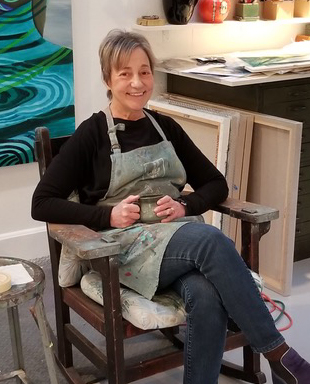
Barbara Grad is an American artist and educator, known for abstract, fractured landscape paintings, which combine organic and geometric forms, colliding planes and patterns, and multiple perspectives. Her work's themes include the instability of experience, the ephemerality of nature, and the complexity of navigating cultural environments in flux. While best known as a painter, Grad also produces drawings, prints, mixed-media works and artist books. She has exhibited in venues including the Art Institute of Chicago, Kemper Museum of Contemporary Art, Danforth Art, Rose Art Museum, Indianapolis Museum of Art and A.I.R., and been reviewed in publications, including Artforum, Arts Magazine and ARTnews. Grad co-founded Artemisia Gallery, one the country's first women-artist collectives, in Chicago in 1973. She has been an educator for over four decades, most notably at the Massachusetts College of Art and Design. Grad has been based in the Boston area since 1987.

Nancy Selvin is an American sculptor, recognized for ceramic works and tableaux that explore the vessel form and balance an interplay of materials, minimal forms, and expressive processes. She emerged in the late 1960s among a "second generation" of Bay Area ceramic artists who followed the California Clay Movement and continued to challenge ceramic traditions involving expression, form and function, and an art-world that placed the medium outside its established hierarchy. Her work has been exhibited at the Los Angeles County Museum of Art (LACMA), Denver Art Museum, Daum Museum of Contemporary Art and Kohler Arts Center, and belongs to the public art collections of LACMA, the Smithsonian Institution, Oakland Museum of California, and Crocker Art Museum, among others. Critic David Roth has written, "Selvin's position in the top rank of ceramic artists has come through a process of rigorous self-examination … what differentiates [her] is that she eschews realism and functionality, indicating a level of intellectual engagement not always found among ceramicists." Writer and curator Jo Lauria described Selvin's tableaux as "elegiac and stylistically unified" works that serve as "forceful essays on the relationship between realism and abstraction, object and subject, decoration and use." Selvin lives and works in the Berkeley, California area.

M. Louise Stanley is an American painter known for irreverent figurative work that combines myth and allegory, satire, autobiography, and social commentary. Writers such as curator Renny Pritikin situate her early-1970s work at the forefront of the "small, but potent" Bad Painting movement, so named for its "disregard for the niceties of conventional figurative painting." Stanley's paintings frequently focus on romantic fantasies and conflicts, social manners and taboos, gender politics, and lampoons of classical myths, portrayed through stylized figures, expressive color, frenetic compositions and slapstick humor. Art historians such as Whitney Chadwick place Stanley within a Bay Area narrative tradition that blended eclectic sources and personal styles in revolt against mid-century modernism; her work includes a feminist critique of contemporary life and art springing from personal experience and her early membership in the Women's Movement. Stanley has been awarded a Guggenheim Fellowship and grants from the Pollock-Krasner Foundation, Adolph and Esther Gottlieb Foundation, and National Endowment for the Arts. Her work has been shown at institutions including PS1, San Francisco Museum of Modern Art (SFMOMA), The New Museum and Long Beach Museum of Art, and belongs to public collections including SFMOMA, San Jose Museum of Art, Oakland Museum, and de Saisset Museum. Stanley lives and works in Emeryville, California.
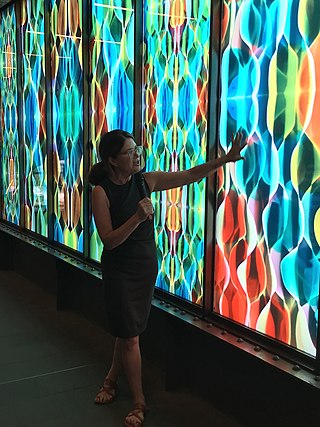
Maureen McQuillan is a New York-based contemporary artist, who, though primarily a painter, has worked in a range of mediums that include drawing, painting, camera-less photography, and sculptural installation. Across disciplines, she uses color and flowing line to create her complexly patterned abstractions.

Louise Belcourt is a Canadian-American artist based in New York, known for elusive, largely abstract paintings that blend modernist formal play, a commitment to the physical world, and a visual language that shifts between landscape and the body, architecture and geometric form. New York Times critic Ken Johnson writes of her earlier work, "balancing adroitly between Color Field abstraction and Pop-style representation, Ms. Belcourt's paintings invite meditation on the perceptual, the conceptual and how our minds construct the world." Describing her later evolution, David Brody writes in Artcritical, "Hard-nosed Canadian empiricism and Brooklyn grit seem to combine in Belcourt’s work to undermine stylistic stasis."

Sharon Butler is an American artist and arts writer. She is known for teasing out ideas about contemporary abstraction in her art and writing, particularly a style she called "new casualism" in a 2011 essay. Butler uses process as metaphor and has said in artist's talks that she is keenly interested in creating paintings as documentation of her life. In a 2014 review in the Washington Post, art critic Michael Sullivan wrote that Butler "creates sketchy, thinly painted washes that hover between representation and abstraction.Though boasting such mechanistic titles as 'Tower Vents' and 'Turbine Study,' Butler’s dreamlike renderings, which use tape to only suggest the roughest outlines of architectural forms, feel like bittersweet homages to urban decay." Critic Thomas Micchelli proposed that Butler's work shares "Rauschenberg’s dissolution of the barriers between painting and sculpture," particularly where the canvases are "stapled almost willy-nilly to the front of the stretcher bars, which are visible along the edges of some of the works."
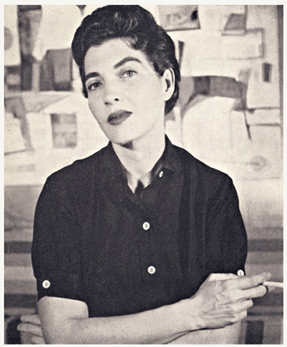
Ethel Fisher was an American painter whose career spanned more than seven decades in New York City, Miami and Los Angeles. Her work ranges across abstraction and representational genres including large-scale portraiture, architectural "portraits," landscape and still-life, and is unified by a sustained formal emphasis on color and space. After studying at the Art Students League in the 1940s, Fisher gained recognition as an abstract artist in Florida in the late 1950s, and began exhibiting nationally and in Havana, Cuba. Her formative work of this period embraced the history of art, architecture and anthropology; she referred to it as "abstract impressionist" to distinguish her approach to form and color from that of Abstract Expressionism.
James Little is an American painter and curator. He is known for his works of geometric abstraction which are often imbued with exuberant color. He has been based in New York City.


















